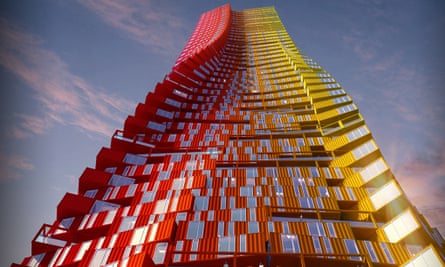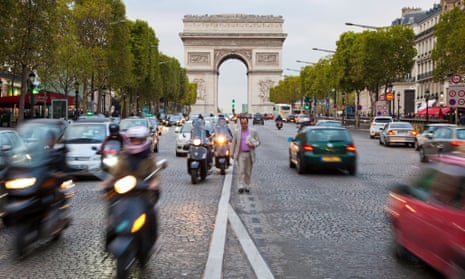The best city stories from around the web this week see Paris gearing up to get rid of cars (for one day only), vacant homes spreading across Tokyo’s satellite cities, a floating food forest in New York and a skycraper made of shipping containers in Mumbai’s Dharavi slum.
We’d love to hear your responses to these stories, and any others you’ve read recently, both on Guardian Cities and elsewhere. Just share your thoughts in the comments below.
Paris without cars
On Sunday 27 September, Paris is planning to go car-free for one day in a bid to encourage more sustainable transport and raise awareness of the dangerously high levels of pollution the city suffers from. As Lori Zimmer writes in Inhabitat, Paris mayor Anne Hidalgo’s inaugural Journée sans voiture will make the French capital “a pedestrian and bicycle paradise” for one day. Hidalgo has in the past introduced emergency measures to reduce cars on the road in order to alleviate pollution, as well as put forward plans for pedestrianisation along the Seine embankment. Could next month’s one-day vehicle ban inspire other cities struggling with air pollution? If only London could give it a try …
Tokyo’s ‘Detroit’ suburbs
“There are empty houses everywhere, places where nobody’s lived for 20 years, and more are cropping up all the time,” says a resident of the city of Yokosuka, outside Tokyo, in Jonathan Soble’s New York Times piece. Soble explains that as population declines and the younger generation moves to the capital, the number of discarded, vacant homes in the area around Tokyo is on the rise. “Tokyo could end up being surrounded by Detroits,” warns real estate expert Tomohiko Makino.
The question now arises of what to do with these properties. Yokosuka has established an online “vacant home bank” to showcase houses that commercial real estate agents will not touch. There is also an art project, the Echigo-Tsumari Art Field, which has taken empty buildings in towns outside of Tokyo and transformed them into contemporary artworks.
Smart buses in Nairobi
Nairobi’s main public transport network, used by 70% of the city’s population, is a system of buses called “matatus”. “They’re cheap and convenient, filling the public transit void,” writes Shara Tonn in Wired. “But the system is chaotic.” Individual buses and routes are privately owned and operated, which means schedules, ticket prices and even stop locations are unreliable.
This week, building on the work of last year’s collaborative Digital Matatus project, the Matatu system became the first informal network to be launched on Google Maps. “Just as New York commuters can plot their subway routes on the service, residents of Nairobi can now jack into the matatu system on their smartphones,” writes Tonn. Through research and four months of riding the buses armed with smartphones, collaborators in the Digital Matatus project created a map of the entire system.

Slum skyscraper
If the vision of CRG Architects goes ahead, the slum of Dharavi in Mumbai will welcome the Container Scraper, a twisting, 1,300-foot skyscraper made out of cargo containers. As Fast Co Design explains, the proposed tower stacks 2,344 containers of various sizes to house approximately 5,000 people – and CRG estimates that the structure could be built for about a third of the price of a more traditionally constructed one – and with the help of drones, too.
Floating forests
And now to New York to yet another city proposal utilising shipping containers. Artist Mary Mattingly’s project Swale envisions a floating food forest on the city’s Hudson river. Built from repurposed shipping containers, the project would stretch 50 feet across and feature a gangway entrance, walkways, and an edible forest garden open to the public. The installation would dock at different piers around the city for months at a time inviting visitors to harvest food from its plants.
“In addition to making food accessible,” Zoe Rosenberg writes in NY Curbed, “the installation will aim to bring awareness to the impact of large-scale supply chains and the excessive waste of food distribution practices.”
Follow Guardian Cities on Twitter and Facebook and join the discussion

Comments (…)
Sign in or create your Guardian account to join the discussion